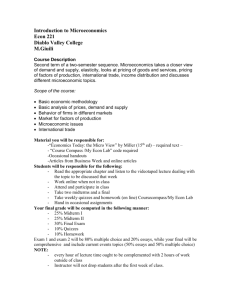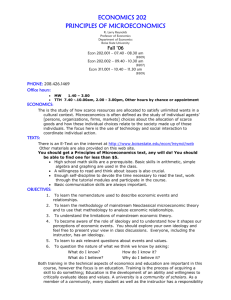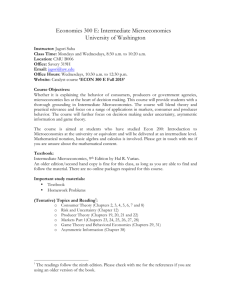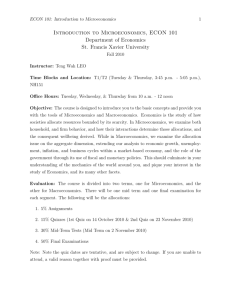Economics 201D: Intermediate Microeconomics I
advertisement
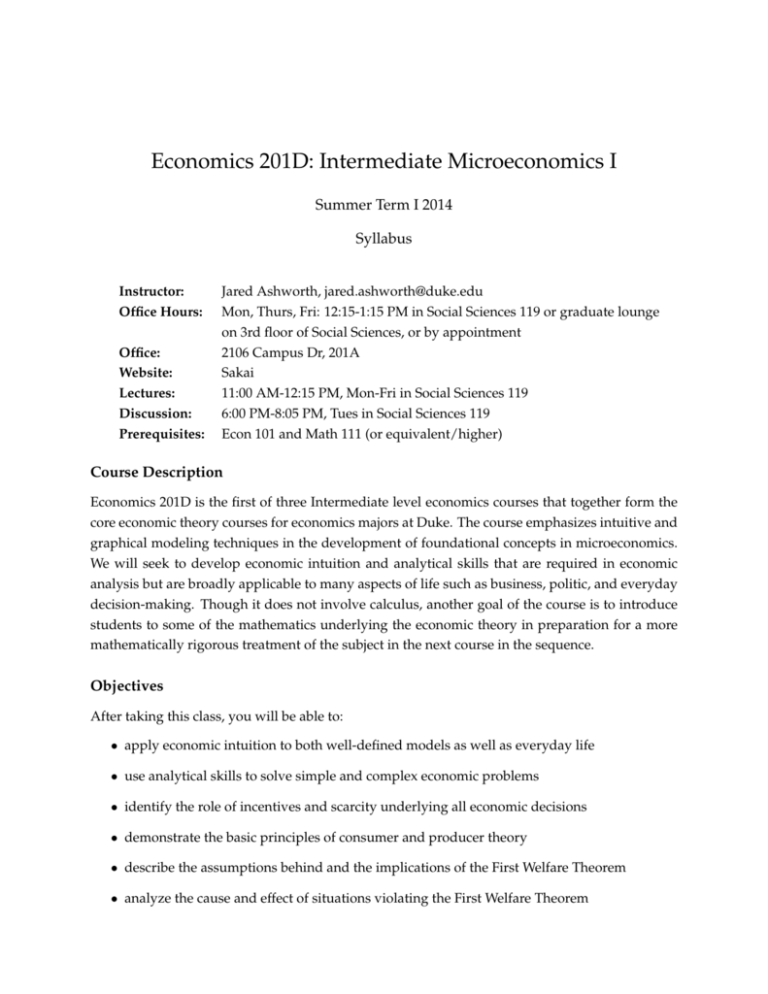
Economics 201D: Intermediate Microeconomics I Summer Term I 2014 Syllabus Instructor: Office Hours: Office: Website: Lectures: Discussion: Prerequisites: Jared Ashworth, jared.ashworth@duke.edu Mon, Thurs, Fri: 12:15-1:15 PM in Social Sciences 119 or graduate lounge on 3rd floor of Social Sciences, or by appointment 2106 Campus Dr, 201A Sakai 11:00 AM-12:15 PM, Mon-Fri in Social Sciences 119 6:00 PM-8:05 PM, Tues in Social Sciences 119 Econ 101 and Math 111 (or equivalent/higher) Course Description Economics 201D is the first of three Intermediate level economics courses that together form the core economic theory courses for economics majors at Duke. The course emphasizes intuitive and graphical modeling techniques in the development of foundational concepts in microeconomics. We will seek to develop economic intuition and analytical skills that are required in economic analysis but are broadly applicable to many aspects of life such as business, politic, and everyday decision-making. Though it does not involve calculus, another goal of the course is to introduce students to some of the mathematics underlying the economic theory in preparation for a more mathematically rigorous treatment of the subject in the next course in the sequence. Objectives After taking this class, you will be able to: • apply economic intuition to both well-defined models as well as everyday life • use analytical skills to solve simple and complex economic problems • identify the role of incentives and scarcity underlying all economic decisions • demonstrate the basic principles of consumer and producer theory • describe the assumptions behind and the implications of the First Welfare Theorem • analyze the cause and effect of situations violating the First Welfare Theorem Econ 201 Syllabus 2 Textbook You can choose one of the following two textbooks for the course: Microeconomics: An Intuitive Approach with Calculus, 1st Edition, Thomas Nechyba ISBN-10:0538453257 or Microeconomics: An Intuitive Approach, 1st Edition, Thomas Nechyba ISBN-10:0538453265 The latter is essentially a sub-set of the former. If you get the larger book with calculus, you will notice that chapters are divided into A- and B-parts, with the math developed in the B-parts. If you get the second smaller book, you are essentially getting the first book with the B-parts removed. (There are some exceptions to this, but essentially this is the difference between the books). Material for this course will come primarily from the A parts of the larger book, with some occasional reference to the B-parts. If you plan to go on in economics, it is recommended that you get the larger text with calculus; if you plan to end your studies of economics with this course, the second (smaller) text is sufficient. The bookstore only has the larger textbook, but you can buy either directly (at a discount) from the publisher at www.cengagebrain.com. At that site, you can also choose to rent either of the texts (for a small fraction of the purchase price), purchase an eBook (at about half the price), or purchase the text by chapter. Note that buying or renting the hardcover from the website comes with a free eBook while you wait for the item to be shipped. Finally, you can purchase access to the LiveGraphs and Study Guide if you buy a used text book. Do not underestimate the value of the Study Guide. Problem Sets Problem Sets will be posted under “Homework” in the folder “Resources” on Sakai. These assignments will necessarily be long and cover a lot of material due to the time constraints of this course. The solutions will be posted on the web (also under “Assignments”). I will NOT be collecting homework at any point. The purpose of the homework is to get you to work hands on with the conceptual material presented in the lectures. The material can look easy in the abstract, but that is in part because there is no way to fully appreciate the nuances of the material without applying it. Taking these problem sets seriously is the single best way to study for this course. For many students, there is a great benefit from working in groups. Writing Assignment You will be asked to watch a series of videos (less than 10 min each) and submit a short reflection on how concepts covered in the class can be applied to the issues brought up in the videos. This will begin after the halfway point in the class at which time I will provide more detailed information. This will be due by 11:55 pm, on Sat, June 21. Econ 201 Syllabus 3 Quizzes and Exams Periodically, during the discussion session, a short quiz will be given on concepts covered in the latest homework. Two midterm exams and one final exam will be given. If you have not spent sufficient time working through the homework problems, the quizzes and exams will be much more difficult for you. Coordinate at least 1 week ahead of time if you know you are going to miss a quiz. There will be no makeup midterms, because you can drop one. Evaluation Your final course score will be: 0.25M1 + 0.25M2 + 0.35F Score = max 0.25M1 + 0.60F 0.25M2 + 0.60F + 0.10Q + 0.05W (1) In words, the midterms will count for 25% of your grade, and the final will count for 35%. However, if it benefits you, one of the midterms will be dropped and the final will count for 60%. The quizzes will count for 10% of your final score, and the writing assignment will count for 5%. Final letter grades will be assigned via a standard rubric: Grade + A B C D F 97-100% 87-89% 77-79% 67-69% 93-96% 83-86% 73-76% 63-66% <=59% 90-92% 80-82% 70-72% 60-62% If necessary, the final percentage earned in the course will be curved by adding the number of percentage points necessary to make the median score equal to 85%. For instance, if the median final grade of the class is 80% then 5% will be added to all scores. Borderline grades will be adjusted upward based on classroom participation. Re-grading Policy Requests for a re-grade must be submitted in writing within three days of the return of the quiz or exam in question. I will disregard any requests made after that. If a re-grading request is based on grading discrepancies between two students, both students must submit their graded material for a re-grade. Please note that the entire quiz or exam, not just the part in question, is subject to re-grading (since mistakes can happen in both directions!). Remember, you are assessed on what is actually written on your paper, not what you meant to write. Econ 201 Syllabus 4 Academic Integrity Duke University is a community dedicated to scholarship, leadership, and service and to the principles of honesty, fairness, respect, and accountability. Citizens of this community commit to reflect upon and uphold these principles in all academic and non-academic endeavors, and to protect and promote a culture of integrity. To uphold the Duke Community Standard: • I will not lie, cheat, or steal in my academic endeavors; • I will conduct myself honorably in all my endeavors; and • I will act if the Standard is compromised. Academic Resource Center Students with disabilities who desire special arrangements are asked to go through the Program for Students with Disabilities and should contact the Academic Resource Center (919-684-5917 or http://www.duke.edu/arc/). You may also refer to ARC for peer tutoring services. The material in this course is cumulative, so I encourage you to seek help as soon as you begin to have difficulties. Disability Statement Students with disabilities who believe that they may need accommodations in the class are encouraged to contact the Office of Services for Students with Disabilities at (919) 684-5917 or disabilities@aas.duke.edu as soon as possible to better ensure that such accommodations are implemented in a timely fashion. Econ 201 Syllabus 5 Schedule WEEK DATE TOPIC READING 1 May 14 May 15 May 16 Introduction/Budgets Indifference Curves and Tastes Tastes and Optimization Ch 1, 2 & 3 Ch 4 & 5 Ch 5 & 6 2* May 19 May 20 May 21 May 22 May 23 Income and Substitution Effects Wealth and Substitution Effects Consumer Demand and Labor Supply Marginal Willingness to Pay and Deadweight Loss Catch-up/Review Ch 7 Ch 8 Ch 9 Ch 10 3 May 26 May 27 May 28 May 29 May 30 Memorial Day - no class Midterm 1 Exam Single Input Production Input Production Cost Minimization and Supply Ch 11 Ch 12 §1-2 Ch 12 §3 4* June 2 June 3 June 4 June 5 June 6 Long Run Supply and Substitution Effects Competitive Industry Equilibrium The First Welfare Theorem Elasticities and Price Distorting Policies Taxes and Subsidies Ch 13 §1-3 Ch 14 Ch 15 Ch 18 Ch 19 5 June 9 June 10 June 11 June 12 June 13 Externalities Catch-up/Review Midterm 2 Exam Risk and Uncertainty Asymmetric Information Ch 21 June 16 June 17 June 18 June 19 June 20 Discrimination Monopoly Game Theory I Game Theory II Oligopoly Ch 22 §4-5 Ch 23 Ch 24 Ch 24 Ch 25 6* 7 Ch 17 §1-2 Ch 22 §1-3 June 23 Catch-up/Review June 24 Reading Day - no discussion section June 25 Final Exam; 2PM - 5 PM * Indicates that a quiz will be given during this week’s discussion section

